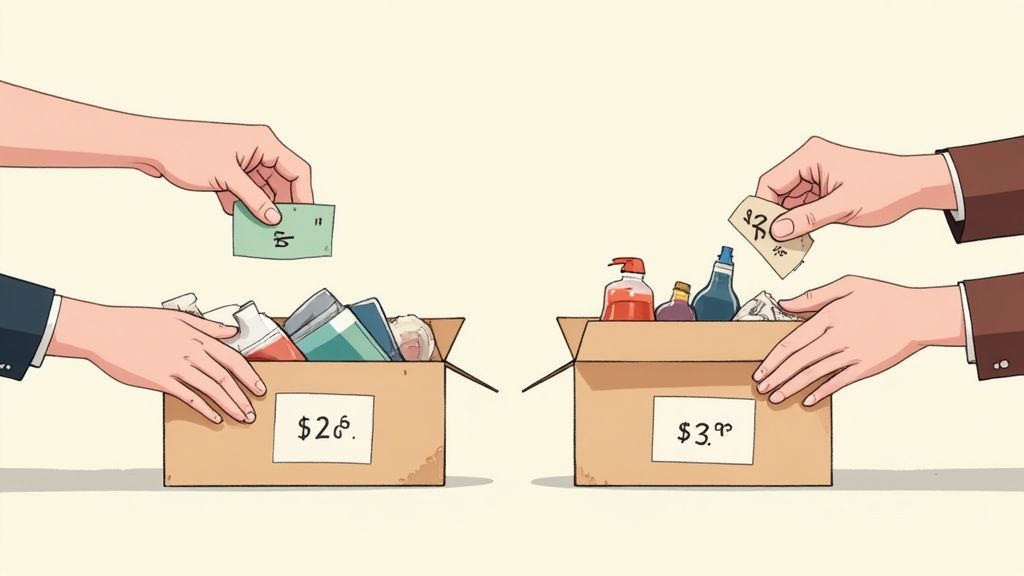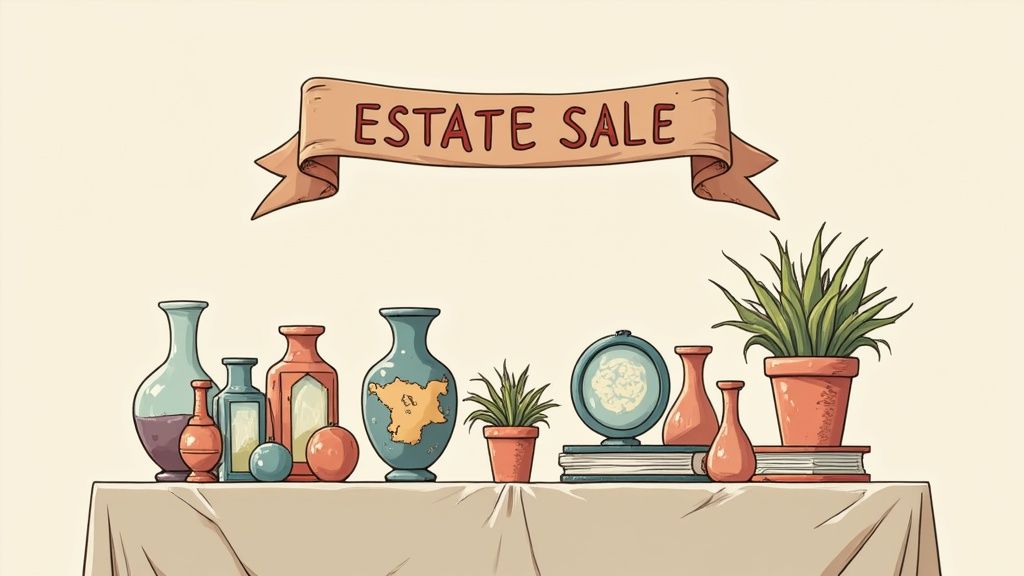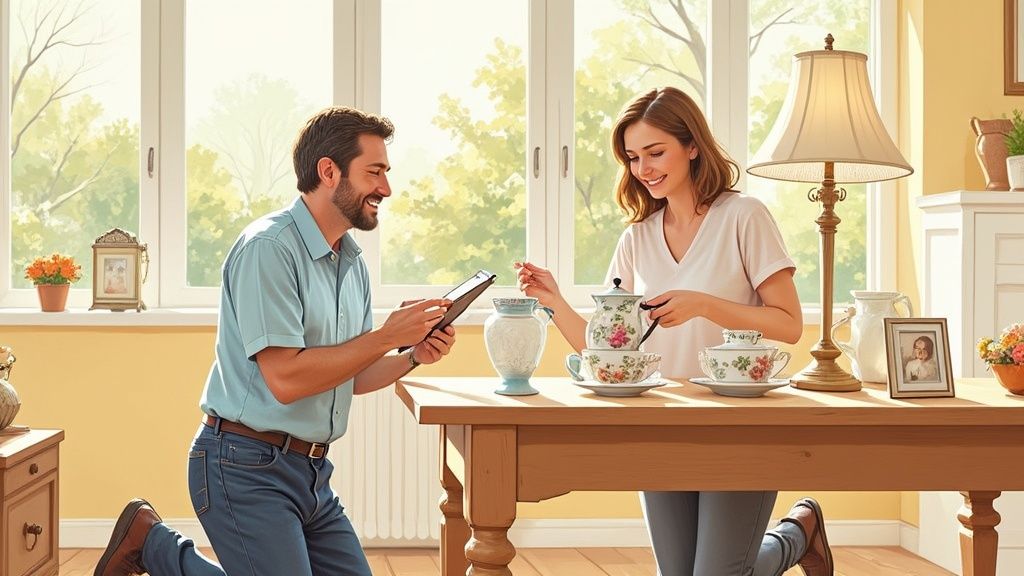Planning Your Estate Sale Like the Pros Do
Getting started on an estate sale can feel like standing at the base of a mountain. Many families find themselves in a home packed with a lifetime of belongings, completely unsure of where to even begin. The secret, as any seasoned professional will tell you, is to stop thinking of it as a massive cleanup and start treating it like a small business launch. It all begins with a solid plan, long before you even think about unlocking the front door for customers.
Assessing Your Inventory With Fresh Eyes
The first real step is a mental one: you have to switch from seeing sentimental treasures to seeing sellable inventory. It's tough, but necessary. Grab a notepad and walk through the entire house, making a quick and decisive initial sort. You'll want three main categories: Keep, Sell, and Discard/Donate. This is often the most emotionally draining part of the whole process, so it helps to set some ground rules first. For instance, you could agree that any item with direct, personal meaning to a living family member automatically goes into the "keep" pile, no questions asked.
As you sort, keep your eyes peeled for unexpected gems. Sure, the fancy china and sterling silver are obvious contenders for the "sell" pile, but don't ignore the less glamorous items. Things like vintage clothing, old hand tools, first-edition books, and even costume jewelry can be big sellers for collectors. On the flip side, don't waste your energy on items with little to no resale value, like old mattresses, stained linens, or board games with missing pieces. If you're feeling stuck, getting some professional estate sale help can offer a clear framework for making these difficult calls.
Strategic Timing and Legal Groundwork
Once you have a general sense of what you're selling, it’s time to get out the calendar. Try to avoid big holiday weekends when your potential customers are likely traveling or busy with their own family events. It’s also a good idea to check your local community calendar. Scheduling your sale on the same weekend as a huge town festival could either draw in more shoppers or create a parking nightmare. As a general rule, weekends in the spring and early fall usually bring out the biggest crowds.
Before you circle a date in permanent marker, do a little homework on local rules. Many towns require you to get a permit for an estate sale, and they often have strict regulations about where you can place your signs. You should also give your homeowner's insurance policy a quick review to see what your liability coverage looks like in case someone has an accident on the property during the sale. These are the kinds of details that separate a smoothly run sale from a chaotic one.
Taking the time for accurate appraisals and careful planning really pays off. In fact, research shows that proper preparation—from pricing to advertising—can increase your final revenue by 20% and boost foot traffic by as much as 30%.
Pricing Strategies That Actually Move Inventory

When you're figuring out how to organize an estate sale, pricing is where art truly meets science. It’s about much more than just slapping stickers on everything; it’s about tapping into buyer psychology. The right price does more than reflect an item's worth—it creates a sense of discovery and urgency that nudges shoppers to make a purchase.
A common rule of thumb is to price items at 10% to 20% of their original retail value, but think of this as a loose guideline, not a strict rule. For example, a vintage Pyrex bowl in a sought-after pattern could easily fetch more than its original price, while a large, formal dining room set might only sell for a tiny fraction of what it once cost.
Research Without the Rabbit Hole
To price items effectively, you need to do a bit of research, but you don't want to get stuck in "analysis paralysis." For everyday things like basic kitchenware or standard furniture, a quick check of sold listings on eBay or Facebook Marketplace will give you a solid idea of their current market value.
For more unique or potentially valuable pieces, like signed artwork or antique jewelry, it's worth digging a little deeper. This is where an app like Curio can be a huge help, giving you instant context and value estimates from just a photo. If you come across something you suspect is exceptionally rare—like a historical document or a high-end designer bag—investing in a professional appraisal is a smart move that can pay for itself many times over. For a more detailed breakdown, you might find our guide on how to price estate sale items for the best return helpful.
To help you get started, here's a table outlining typical pricing ranges for common estate sale categories.
| Item Category | Typical Estate Sale Price | Retail Value % | Best Selling Days |
|---|---|---|---|
| Furniture (Modern) | $50 - $300 | 10% - 30% | Friday, Saturday |
| Furniture (Antique/Vintage) | $100 - $1,000+ | 20% - 50%+ | Friday, Saturday |
| Clothing (Designer) | $20 - $150 | 15% - 35% | Friday |
| Clothing (Everyday) | $1 - $10 | 5% - 15% | Saturday, Sunday |
| Books & Media | $1 - $5 (or bundled) | <10% | Sunday (as bundles) |
| Kitchenware & Glassware | $1 - $25 | 10% - 30% | Saturday |
| Jewelry (Fine) | Varies (Appraisal needed) | 25% - 50%+ | Friday |
| Jewelry (Costume) | $1 - $15 (or bundled) | 5% - 20% | Saturday, Sunday |
| Tools & Garage Items | $5 - $50 | 15% - 40% | Friday |
| Art & Collectibles | Varies (Research needed) | 20% - 60%+ | Friday |
This table shows that while some items, like everyday clothing, sell for a small fraction of their retail price, collectibles and high-demand antiques can command a much higher percentage. Notice how the "best selling days" often align with when the most serious buyers shop (Friday) versus when bargain hunters arrive (Sunday).
The Power of Grouping and Bundling
Not every single item in the sale needs its own price tag. In fact, grouping items can be a highly effective way to move lower-value goods and clear out clutter. Instead of trying to sell one paperback for $1, try setting up a “$5 a Bag for Books” station.
This strategy is fantastic for things like:
- Kitchen utensils
- Costume jewelry
- Linens and towels
- Craft supplies
This approach doesn't just clear tables quickly; it also makes shoppers feel like they've scored an amazing deal. You can also create curated bundles, sometimes called "vignettes." Imagine placing a few old cookbooks, a vintage apron, and a rustic rolling pin together and selling them as a "Baker's Dream" set. This tells a story and helps buyers visualize the items in their own homes, making the bundle far more appealing than if the items were scattered across different tables. This kind of strategic positioning can make ordinary items feel special and much more desirable.
Marketing That Brings Serious Buyers to Your Door
 Once your items are priced and staged, your success hinges on getting the right people through the door. Effective marketing is the difference between a trickle of bargain hunters and a steady stream of serious buyers ready to spend. When figuring out how to organize an estate sale, your advertising strategy should be just as carefully planned as your pricing. It all starts with knowing where your ideal buyers are looking for sales in your area.
Once your items are priced and staged, your success hinges on getting the right people through the door. Effective marketing is the difference between a trickle of bargain hunters and a steady stream of serious buyers ready to spend. When figuring out how to organize an estate sale, your advertising strategy should be just as carefully planned as your pricing. It all starts with knowing where your ideal buyers are looking for sales in your area.
For a broad reach, listing on dedicated websites like EstateSales.net is practically a requirement. These platforms are the go-to resource for die-hard fans and professional resellers. However, don’t sleep on the power of local social media. A well-crafted post in a community Facebook group or on Nextdoor can attract neighbors who might not be actively searching for sales but are drawn in by curiosity. These are often the people who fall in love with a piece of furniture they can easily walk home. You can also explore our guide on how to find estate sales to see where your customers are searching.
Crafting Compelling Listings
Your online sale description is your first, and most important, sales pitch. The goal is to build excitement and anticipation without giving everything away at once.
Here’s how to write a listing that gets people interested:
- Lead with the Best: Mention two or three "hero" categories right in your headline, like "Mid-Century Modern Furniture & Vintage Tool Collection." This immediately grabs the attention of collectors.
- Tell a Story: Instead of just a dry list of items, briefly describe the collection’s origin. For example, "A lifetime collection from a passionate world traveler and artist" adds a layer of intrigue that a simple list can't match.
- Show, Don't Just Tell: Photography is everything. Take bright, clear photos of your most desirable items and compelling room vignettes. Blurry or dark images will kill interest before it even starts.
- Be Clear on Logistics: Make sure the sale dates, times, and address are easy to find. For security, some people prefer to release the full address the day before the sale. Also, clearly state the payment methods you'll accept.
Reaching a Wider Audience
These days, your best buyer might not even live in the same country. This is especially true if you're dealing with high-end collections that include fine art, antiques, or luxury goods. In fact, major US cities have seen a 15-20% increase in international buyers at luxury estate sales since 2022. In some sales, these buyers account for a quarter of the total revenue. This global interest can seriously boost your final returns. Check out more on the growing international interest in high-end estate sales to see if your items might have a global appeal.
Staging Your Sale for Maximum Visual Impact
The real difference between a chaotic garage sale and a professional estate sale often comes down to presentation. Smart staging is much more than just a quick cleanup; it’s about crafting an experience that helps shoppers imagine your items in their own homes. When you're figuring out how to organize an estate sale, your mindset should shift from someone emptying a house to a merchandiser arranging a boutique. Your mission is to make browsing and buying as easy and pleasant as possible.
Creating Flow and Function
Your first job is to manage traffic flow. A house crammed with furniture can quickly turn into a bottleneck, which is frustrating for shoppers and can even be a safety issue. You'll want to map out clear, wide paths through every room. This might mean pushing big furniture pieces like sofas and dressers against the walls or even moving some items out temporarily to open up a main aisle. The idea is to let people move around comfortably without feeling cornered or bumping into others.
Next, set up a dedicated checkout area, ideally close to the main exit. This spot needs to be obvious and have enough room for a small table, your cash box, and a holding area for items shoppers have picked out. A classic mistake is forgetting to create a “claimed section” or hold area. People will want a place to stash their finds while they keep looking. Pick a specific table or corner for these piles to avoid mix-ups and keep your walkways clear. It’s also a good idea to have some bags and boxes on hand to help people carry their new treasures home.
Displaying Items to Sell
With a good layout in place, you can turn your attention to the displays. The secret is to group similar items together and make sure everything is easy to see and reach.
Here’s how you can transform cluttered rooms into inviting, shoppable spaces:
- Create Themed Zones: Assign specific areas to different categories. Put all the kitchen gadgets and dishes in the kitchen, tools in the garage, and books in the living room. This feels natural to shoppers and helps them find exactly what they’re looking for.
- Use Vertical Space: Don't just lay everything out flat on tables. Use existing bookshelves to show off glassware, collectibles, and books. This draws the eye upward and makes the space feel more like a real store.
- Build Attractive Vignettes: Instead of tossing linens in a pile, fold them neatly and place them in a wicker basket. Arrange a few related decor pieces on an end table to give people an idea of how they could look together. These little touches help shoppers visualize the items in their own lives.
- Prioritize Lighting and Cleanliness: A bright, clean space instantly makes your items seem more valuable. Open up all the curtains, turn on every light, and give everything a quick wipe-down. Dusty, poorly lit items look cheap, regardless of their actual worth.
By treating your sale like a pop-up shop, you build an atmosphere where people are happy to spend their time and money, which will significantly boost your chances of a successful event.
Mastering Your Sale Weekend Like a Seasoned Pro
 After all the sorting, staging, and pricing, the sale weekend is showtime. This is where your hard work really shines, and your ability to juggle people, prices, and payments will make or break your success. Think of it less like a frantic sprint and more like a well-paced marathon. Keeping your energy and attitude positive is just as critical as knowing when to strike a deal.
After all the sorting, staging, and pricing, the sale weekend is showtime. This is where your hard work really shines, and your ability to juggle people, prices, and payments will make or break your success. Think of it less like a frantic sprint and more like a well-paced marathon. Keeping your energy and attitude positive is just as critical as knowing when to strike a deal.
Handling Crowds and Difficult Customers
The first hour of any estate sale can feel like a whirlwind. Get ready for the early birds—these are often experienced resellers and serious collectors who arrive with a mission. They know what they're looking for, move quickly, and can be quite assertive. To manage this initial rush, make sure you have a single, clear entry and exit point. If the house is on the smaller side, consider letting people in a few at a time. It’s far better to have a manageable line outside than a chaotic and potentially unsafe mob scene inside.
You’ll meet all kinds of shoppers over the weekend. Some are just casually browsing, while others will be ready to haggle hard. The secret is to remain polite but firm. For instance, if you get a ridiculously low offer on the first morning, a great response is, "Thanks for your interest! Prices are firm for today, but you're welcome to check back tomorrow to see if it's still here." This approach sets a clear expectation without coming off as rude.
Effective Negotiation and Payment Processing
Knowing when to negotiate is a key part of learning how to organize an estate sale. On day one, it’s usually best to hold firm on your prices, especially for those in-demand pieces you know will sell. As you move into the second or final day, that’s when flexibility becomes your greatest asset.
To help you visualize the flow of a typical sale weekend, here's a breakdown of how pricing strategies and buyer behavior often unfold. This can help you anticipate the rhythm of the sale and adjust your approach accordingly.
| Sale Day | Time Period | Pricing Strategy | Typical Buyer Type | Sales Volume |
|---|---|---|---|---|
| Day 1 | 8 AM - 10 AM | Prices are firm. No discounts. | Serious collectors, resellers, "early birds" | High |
| Day 1 | 10 AM - 1 PM | Stick to pricing. Minimal negotiation on bundles. | Avid hobbyists, determined decorators | Moderate |
| Day 1 | 1 PM - 4 PM | Consider small (10-15%) discounts on larger purchases. | Casual shoppers, local neighbors | Steady to Slow |
| Day 2 | 9 AM - 12 PM | Introduce a standard discount (e.g., 25% off most items). | Bargain hunters, returning shoppers | High |
| Day 2 | 12 PM - 4 PM | Increase discount to 50% off. Announce "make an offer." | Last-minute deal seekers, liquidators | Moderate but Urgent |
As you can see from the table, your strategy should evolve. A great tactic for the final hours is to announce a blanket discount, like “50% off everything with a blue sticker.” This creates a sense of urgency and is incredibly effective at clearing out what’s left.
When it comes to payments, be ready for anything. Cash is king, but offering digital payment options like Venmo or using a card reader from a service like Square can dramatically boost your sales, since many people don't carry much cash. Have a designated checkout area with a cash box containing at least $100 in various bills and coins for change. Nothing kills a sale faster than not being able to break a large bill.
Finally, pay attention to items that aren't getting any love. Don't be afraid to rearrange things or create bundles to spark new interest. That lonely lamp might suddenly catch someone's eye if you move it next to an armchair. Your ability to adapt on the fly is what will turn a good sale into a great one.
Timing Your Sale for Maximum Market Impact
You can have the most beautifully staged and perfectly priced estate sale, but if you get the timing wrong, it can all fall flat. When you're figuring out how to organize an estate sale, one of the most professional things you can do is sync your event with what's happening in the market. This single strategy can give your final profits a serious boost.
Understanding Seasonal and Economic Rhythms
The time of year you choose to hold your sale has a huge effect on how many people show up. Generally, spring and early summer are the prime seasons for estate sales. The weather is nice, people are in a "fresh start" mood, and there's just more foot traffic. On the flip side, trying to run a sale during a major holiday weekend or in the dead of winter can seriously limit your audience.
Beyond the calendar, it's smart to take a look at the bigger economic picture. When the economy feels a bit shaky, people's shopping habits change. They might be more interested in practical items they actually need, rather than splurging on high-end collectibles. This doesn’t mean you can't have a great sale, but you might need to tweak your pricing and marketing to highlight value and usefulness instead of luxury. Learning to read the room, both literally and economically, is a skill that pays off.
Aligning with the Local Real Estate Market
Here’s a powerful strategy that many people miss: align your sale with the local real estate market. When the housing market is buzzing, more people are moving, furnishing new homes, and actively hunting for furniture and decor. This gives you a ready-made audience of highly motivated buyers. In fact, there's a clear link between real estate booms and estate sale success. Some organizers report that timing their sales with an upturn in the local market can lead to returns that are up to 15% higher. You can get a better sense of how global real estate trends influence local markets to understand these connections more deeply.
Before you circle a date on the calendar, do a little local recon.
- Hop on a site like EstateSales.net and monitor it for a week or two. See how many other sales are popping up in your area. You want to avoid a weekend where you're just one of a dozen sales, splitting the customer base.
- Keep an eye on the local events calendar. A massive city-wide festival might seem like a great way to attract people, but it can also create a parking nightmare and pull attention away from your event.
By strategically picking a weekend with plenty of motivated buyers and not too much competition, you give your sale the best possible chance to be a standout success.
Wrapping Up Your Sale and Maximizing Final Returns
 The doors have closed and the last shopper has gone home, but the job isn't quite done. This final phase is a critical part of running a successful estate sale, where leftover items can still add to your total earnings and bring a sense of closure to the whole process. It’s tempting to just pack it all up and be done, but a little extra effort with the remaining inventory can pay off.
The doors have closed and the last shopper has gone home, but the job isn't quite done. This final phase is a critical part of running a successful estate sale, where leftover items can still add to your total earnings and bring a sense of closure to the whole process. It’s tempting to just pack it all up and be done, but a little extra effort with the remaining inventory can pay off.
Handling Unsold Inventory Strategically
Take a moment to quickly scan what’s left. You’ll want to pull aside any items that didn’t sell but clearly still have some real value. Sometimes, a piece of fine art or a niche collectible just needs a different audience than the one at a general estate sale.
For these more valuable leftovers, you have a few great options:
- Consignment Shops: These are perfect for stylish furniture, designer apparel, or eye-catching decor. The shop handles the selling, and you get a cut of the final price.
- Specialized Dealers: Have a collection of old coins, military medals, or stamps? A specialized dealer will often buy the whole lot, giving you a fair price without the hassle of selling individual pieces.
- Online Marketplaces: Platforms like eBay or Facebook Marketplace connect you with a global audience, making it easier to find that one person who’s been searching for exactly what you have.
Donations and Documentation
For everything else, donating is usually the smartest move. Charities like Goodwill or Habitat for Humanity often provide pickup services for large donations, which can be a lifesaver after an exhausting sale weekend. Make sure you get a detailed, itemized receipt for every donation. This piece of paper is crucial for tax time, as it's your proof for claiming a charitable deduction.
File this receipt with your other sales records, which should include a straightforward tally of your total earnings. Keeping clear records of both your income and your donations gives you a complete financial summary of the sale and makes tax season much less stressful.
It takes a final push of energy to get through these last tasks, but this is where you can squeeze a little more value from what's left. Whether it’s through a clever resale or a well-documented donation, you're turning clutter into a positive outcome. And if you’ve decided to keep a few special items but don't know much about them, Curio can help. Just snap a photo, and you can uncover the history and value of your new keepsakes. Download Curio today and let the discovery continue.
